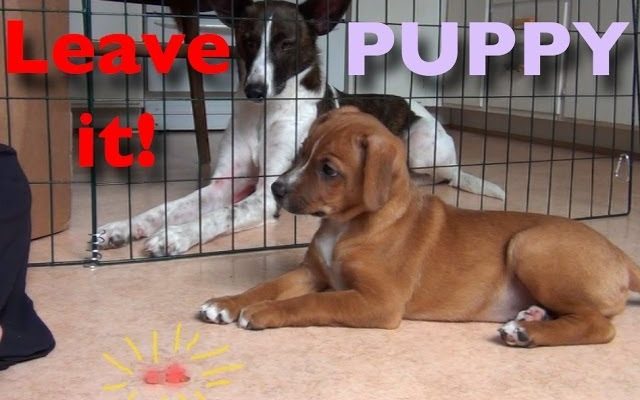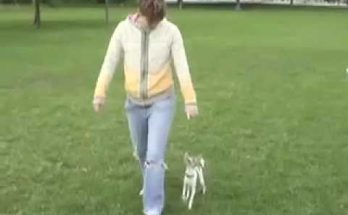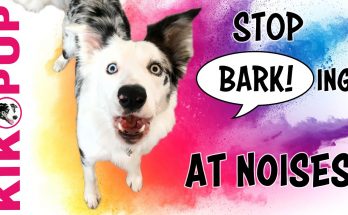Visit our website: http://dogmantics.com/
Buy our new ebook: http://dogmantics.com/shop/
Become a fan on facebook:
http://www.facebook.com/pages/Dogmantics-Dog-Training/75289166216
SUBSCRIBE TO THIS CHANNEL TO SHOW YOUR SUPPORT! We appreciate it:
http://www.youtube.com/subscription_center?add_user=kikopup
Puppy Leave It- Clicker Dog Training Tips
Kikopup spends nearly all of her time making free training videos and educating the public for free. If you would like to make a donation to support her work, simply go to the link below and click on the donate button. You can donate as little or much as you like. My dream would be to be able to support myself from creating free content that everyone around the world could access no matter what their situation! http://www.dogmantics.com/Site_5/Donate.html
Teaching 'Leave It' to a puppy is actually easier than teaching it to an adult dog. Remember to continue to raise criteria as you go, puppies can figure things out as fast as lighting, and if you don't keep raising criteria as your puppy succeeds you will get trapped on the same level of behavior.
Once your puppy can leave food in your hand on the floor, see if your puppy can leave uncovered food. Then try different types of food, in different locations! Add your cue! Add distance! Stay tuned for leave it series 3 where you will learn how to create distance as well as use the cue for other things such as leaving other dogs, people and other distractions besides food.





in my country, most of those who have good dogs get beaten till the dogs whine when they do something wrong. Somehow they turned out obedient but i hate this kind of treatment. I’m so glad i can share this vid with those ignorant fools haha. I’m really fortunate to find this channel as i would be getting a puppy soon. 😀 tyvm!!!!!!!
Thanks for all the great videos – I just have one question. I know you don’t like the ‘error’ sound that some people make while training, and in leave it, I understand why (impuse control) but for more complex tricks, would it be ok to have a “no, that’s not quite what I was going for, try again” word or noise if it’s weren’t intimidating? I’m not well read on animal/dog physiology, but I know that positive and negative markers are very useful for humans, is this the same for dogs?
You’re using Premack. I know, cause I watched Disc 3 of “101 Ways to Think Outside the Box” last night. 🙂
Hi is there anything else you can put on a clicker to muffle it besides poster tack. Like maybe gum or something like that. Thank you 😉
kikopup, I need your help.
I’ve been watching your videos for over a year now, and I have a ZERO % success rate.
How long should it take me to train my 2yr old schnauzer to unlearn bad behaviors and learn good ones (impulse control, fear of other dogs, hyper when first seeing us, etc.)?
What a civilized way to teach !
Such a cute puppy! Awesome video !
@Rienei How wonderful that you will be setting a great example in your country! Don’t let anyone nag at you or rush you into using the wrong training methods. Yes, you can train animals (even children) through cruelty, but you will not have a loving bond like you do with Positive Reinforcement Training. I hope you have subscribed to Kikopup’s channel and you’re watching all of her videos – you will have the happiest and most well trained puppy in your country!
Hello Kikopup,
I have watched almost all your videos and have applied them to my 1 year old lab puppy. I tried socializing her early (2 1/2 months) but she was extremely timid and scared of the other dogs, especially the larger ones. After a while, i thought she would simply warm up to the dog, but she has been getting worse and worse. She now lunges at other dogs when she is on a leash and bares her teeth. This is a total embarrassment. I’m sure i made a mistake somewhere along the line. help?
@BVoshol i like to use “oops” or “almost” in a happy tone when my dog isn’t doing a trick right or missed something 🙂 It’s not intimidating, of course it’s all in the tone of voice you use and your energy. Last thing you want, is to be frustrated or angry around your dog, they easily sense that and training can become difficult if you are always feeling that way.
I was doing pure positive training but with voice commands (such as leave it, or watch me), and gentle correction words (such as uh-uh, or wrong without any emotion), and getting so-so results. You have taught me to have the dog figure out the behavior through trial and error, but without the verbal or eye-contact queues, the “correct” behavior is much stronger and I feel my dogs are working through issues by using their mental facilities and engaging ME instead of me engaging them! 🙂
@mrscurlycues I have this same issue with one of my two English Springer Spaniels. We did all the exercises to socialize him early, and although he was never shy with other dogs, he was a pushy player who suddenly turned leash aggressive at about 11 months old. Kikopup can give you more tips, but now that my dog is 2.5 we are going back to basics. I’m watching my level of frustration with him, and examining how we give food treats. Some dogs are reactive, though, so don’t be too hard on yourself
Im not a training expert but you have to try and distract your dog as soon as it happens. Give a quick pull on the leash, make sure you give your dog high value treats every time you are able to distract it until it learns to look for the treats instead of being scared. Your dog has to learn to associate the unpleasant experience of meeting another dog with something pleasant (the treats)
Hello
I have a question
My dog knows not to touch food when we are home (her or ours without permission) but acts so differently when we are outdoor
Do you have any advice or a video about the subject?
reward your dog when you are at home and when you are outdoors when it is doing what you want to let it know that good behaviour outside is just as appreciated as good behaviour at home
Hey fellow youtubers., turn your nightmare dog into a perfectly behaved member of the family by going to onlinedogtraining .us and downloading their free ebook
ty so much
Dear Emily, I am thinking about the difference between “Leave it” and the attention noise. In my head the subtext for both cues is similar to “Turn away from that thing and look at me”. Would you use “leave it” for food and the attention noise more general?
Thanks so much for this! I have a 4 month old frenchie. I alternate training between physical and cognitive goals, and in different locations so he doesn’t get stuck in a loop. In the past, I have successfully worked on leave it and take it by placing food on the ground and covering with my hand, then picking up to reward after “Yes”. Yesterday I did one 10 minute session, but included some with the food in my hand, palm up. I also added dropping from a distance and walking away. This morning while attempting to practice a heel, he would not lure! He behaved as if I was doing a leave it and watched me instead. I tried moving to another location, and then finally increased the treat value and that seemed to help. I wonder if doing Leave it in the hand is not a good idea? We have accomplished a lot of work using luring and I don’t want to break our ability to do this! Thanks so much for any tips.
I’m glad I found you! I subscribe to 3 other trainers. I like your explanation as you train. I also like how you show us to prioritize.
💜
So I’m a imagine if you don’t have a clicker, you can just say “Leave it” at the same time.